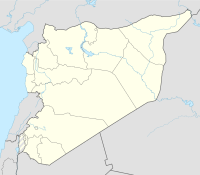This article needs additional citations for verification. (February 2023) |
Serjilla (Arabic: سيرجيلة) is one of the best preserved of the Dead Cities in northwestern Syria, containing about 700 sites. It is located in the Jebel Riha, approximately 65 km north from Hama and 80 km southwest from Aleppo, very close to ruins of another "Dead City", Bara.[1]
سيرجيلة | |
 Ruins of Serjilla | |
| Location | Idlib Governorate, Syria |
|---|---|
| Coordinates | 35°40′12″N 36°34′08″E / 35.670°N 36.569°E |
| Type | settlement |
| Part of | Dead Cities |
| History | |
| Founded | ca. 473 AD |
| Abandoned | Seventh century AD |
| Cultures | Byzantine |
| Site notes | |
| Excavation dates | 1899—present |
| Condition | ruined |
| Ownership | Public |
| Public access | Yes |
The settlement arose in a natural basin and prospered from cultivating of grapes and olives. The presence of a bath complex indicates the wealth of the community. Serjilla, a Byzantine settlement, was built in 473.[2] Thomas Joseph Shanan considered Serjilla as "Pompeii of the East".
History
editCharles-Jean-Melchior de Vogüé, a French archaeologist, did the first scientific studies in 1860s. In 1899, an archaeological team from Princeton University discovered a large mosaic on the main hall floor, but it had disappeared when the team returned six years later. Traces of now destroyed murals were found on the walls as well.[further explanation needed] Next to the baths stands an andron, a meeting place for men. Further east, there was a small church but not much remains of it. Among ruins of numerous residential houses, a two storey villa which still stands today. In two lower rooms, one can still see an arch which supported the ceiling. This feature was typical in the Dead Cities. Behind the villa, there is a sunken building with an olive press. In Serjilla, limestone-mining was a very common and mature industry. Even the empty space left by mining activities were useful. Sometimes mining took place right under the buildings.
Like most other of the Dead Cities, Serjilla was abandoned in the seventh century when the Arabs conquered the region and discontinued merchant routes between Antioch and Apamea.
In 2011, because of the Syrian civil war, UNESCO put Serjilla on the list World Heritage in Danger.
Gallery
edit-
Sarcophaguses
-
Arch of the church
-
Walls and gate
-
Two storey villa
-
Public baths
-
The church
-
The press-house
References
edit- ^ Greenhalgh, Michael (2016). Syria's Monuments: Their Survival and Destruction (Volume 5). Brill. ISBN 978-90-04-33460-1.
- ^ Fangi, Gabriele (2015). "Documentation of some Cultural Heritage Emergencies in Syria in August 2010 by Spherical Photrammetry". ISPRS Annals of the Photogrammetry, Remote Sensing and Spatial Information Sciences. 11-5w3: 401–408. Bibcode:2015ISPAn.II5..401F. doi:10.5194/ISPRSANNALS-II-5-W3-401-2015. S2CID 60909416.
External links
edit- Simeon Citadel and Dead Cities, Suggestion to have Serjilla recognized as a UNESCO world heritage site, in 2006, as part of "Simeon Citadel and Dead Cities"-project.
- Syria Gate
- MidleEast.com
